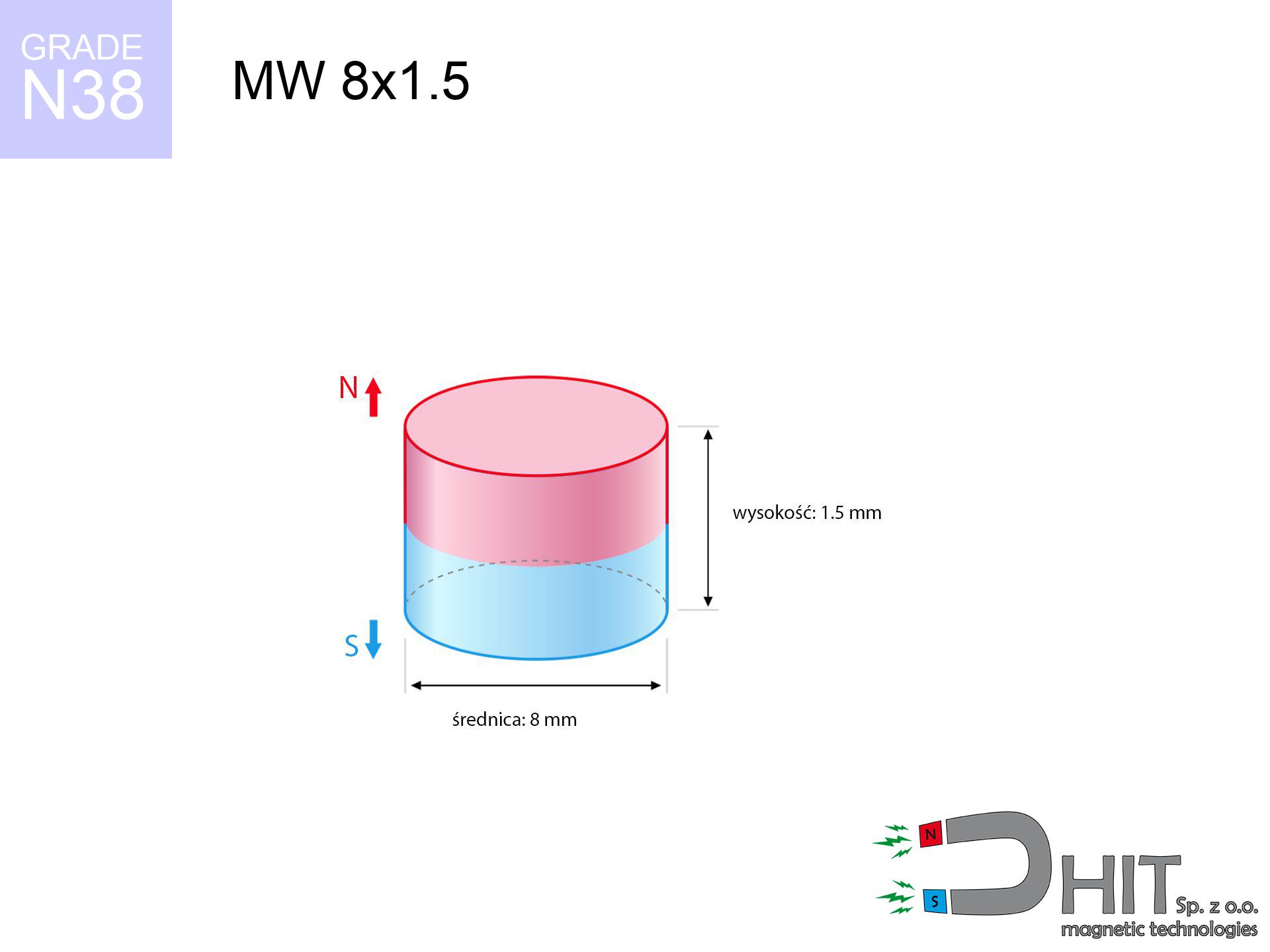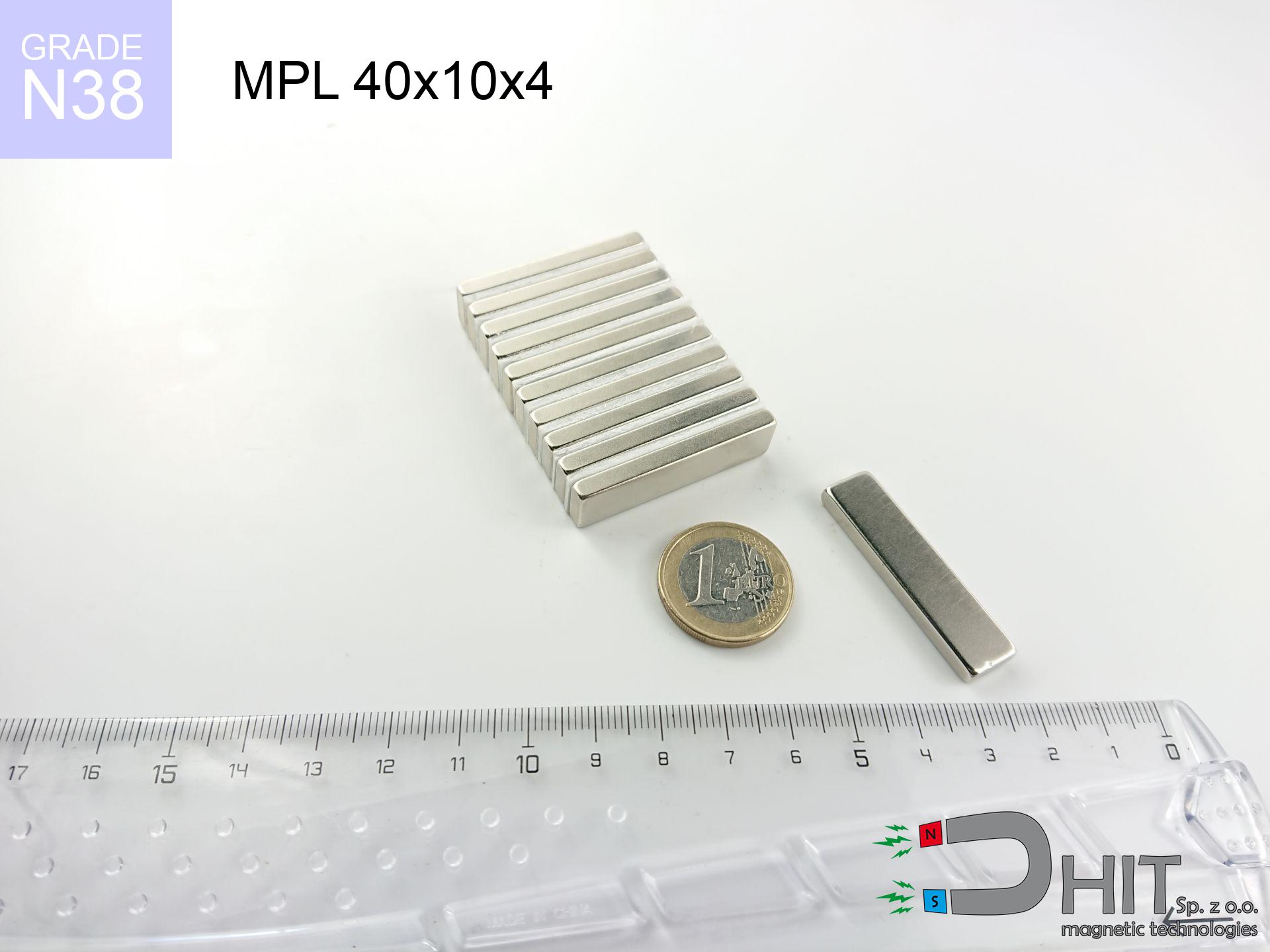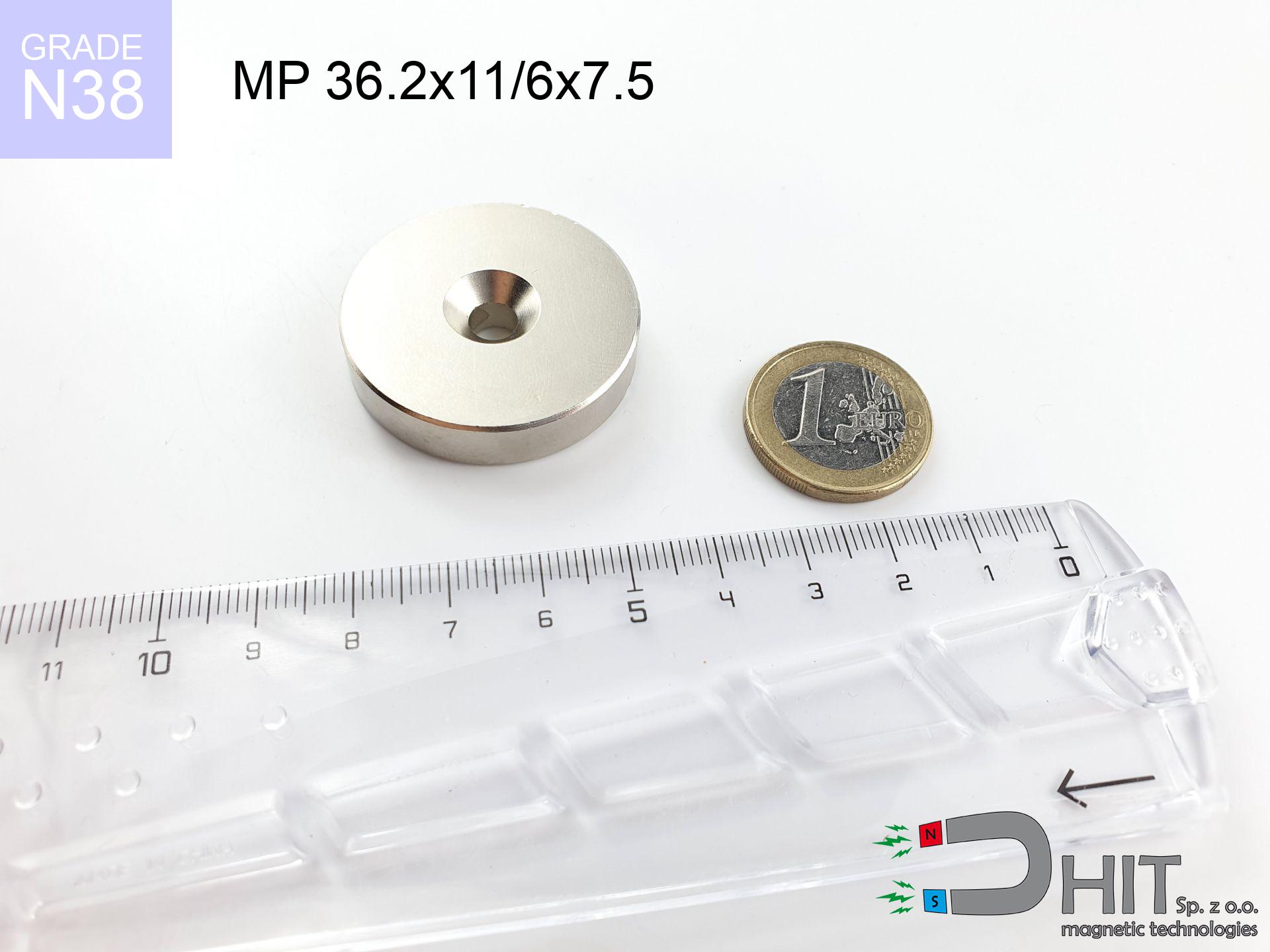MW 8x1.5 / N38 - cylindrical magnet
cylindrical magnet
Catalog no 010101
GTIN/EAN: 5906301811008
Diameter Ø
8 mm [±0,1 mm]
Height
1.5 mm [±0,1 mm]
Weight
0.57 g
Magnetization Direction
↑ axial
Load capacity
0.74 kg / 7.27 N
Magnetic Induction
217.52 mT / 2175 Gs
Coating
[NiCuNi] Nickel
0.455 ZŁ with VAT / pcs + price for transport
0.370 ZŁ net + 23% VAT / pcs
bulk discounts:
Need more?
Call us
+48 888 99 98 98
alternatively send us a note using
request form
through our site.
Specifications and shape of magnetic components can be estimated on our
online calculation tool.
Orders submitted before 14:00 will be dispatched today!
Technical parameters - MW 8x1.5 / N38 - cylindrical magnet
Specification / characteristics - MW 8x1.5 / N38 - cylindrical magnet
| properties | values |
|---|---|
| Cat. no. | 010101 |
| GTIN/EAN | 5906301811008 |
| Production/Distribution | Dhit sp. z o.o. |
| Country of origin | Poland / China / Germany |
| Customs code | 85059029 |
| Diameter Ø | 8 mm [±0,1 mm] |
| Height | 1.5 mm [±0,1 mm] |
| Weight | 0.57 g |
| Magnetization Direction | ↑ axial |
| Load capacity ~ ? | 0.74 kg / 7.27 N |
| Magnetic Induction ~ ? | 217.52 mT / 2175 Gs |
| Coating | [NiCuNi] Nickel |
| Manufacturing Tolerance | ±0.1 mm |
Magnetic properties of material N38
| properties | values | units |
|---|---|---|
| remenance Br [min. - max.] ? | 12.2-12.6 | kGs |
| remenance Br [min. - max.] ? | 1220-1260 | mT |
| coercivity bHc ? | 10.8-11.5 | kOe |
| coercivity bHc ? | 860-915 | kA/m |
| actual internal force iHc | ≥ 12 | kOe |
| actual internal force iHc | ≥ 955 | kA/m |
| energy density [min. - max.] ? | 36-38 | BH max MGOe |
| energy density [min. - max.] ? | 287-303 | BH max KJ/m |
| max. temperature ? | ≤ 80 | °C |
Physical properties of sintered neodymium magnets Nd2Fe14B at 20°C
| properties | values | units |
|---|---|---|
| Vickers hardness | ≥550 | Hv |
| Density | ≥7.4 | g/cm3 |
| Curie Temperature TC | 312 - 380 | °C |
| Curie Temperature TF | 593 - 716 | °F |
| Specific resistance | 150 | μΩ⋅cm |
| Bending strength | 250 | MPa |
| Compressive strength | 1000~1100 | MPa |
| Thermal expansion parallel (∥) to orientation (M) | (3-4) x 10-6 | °C-1 |
| Thermal expansion perpendicular (⊥) to orientation (M) | -(1-3) x 10-6 | °C-1 |
| Young's modulus | 1.7 x 104 | kg/mm² |
Physical simulation of the product - report
These values are the result of a mathematical simulation. Results are based on models for the class Nd2Fe14B. Operational performance might slightly differ from theoretical values. Use these calculations as a reference point during assembly planning.
Table 1: Static force (force vs gap) - interaction chart
MW 8x1.5 / N38
| Distance (mm) | Induction (Gauss) / mT | Pull Force (kg) | Risk Status |
|---|---|---|---|
| 0 mm |
2174 Gs
217.4 mT
|
0.74 kg / 740.0 g
7.3 N
|
low risk |
| 1 mm |
1782 Gs
178.2 mT
|
0.50 kg / 497.3 g
4.9 N
|
low risk |
| 2 mm |
1310 Gs
131.0 mT
|
0.27 kg / 268.7 g
2.6 N
|
low risk |
| 3 mm |
914 Gs
91.4 mT
|
0.13 kg / 130.8 g
1.3 N
|
low risk |
| 5 mm |
439 Gs
43.9 mT
|
0.03 kg / 30.2 g
0.3 N
|
low risk |
| 10 mm |
99 Gs
9.9 mT
|
0.00 kg / 1.5 g
0.0 N
|
low risk |
| 15 mm |
35 Gs
3.5 mT
|
0.00 kg / 0.2 g
0.0 N
|
low risk |
| 20 mm |
16 Gs
1.6 mT
|
0.00 kg / 0.0 g
0.0 N
|
low risk |
| 30 mm |
5 Gs
0.5 mT
|
0.00 kg / 0.0 g
0.0 N
|
low risk |
| 50 mm |
1 Gs
0.1 mT
|
0.00 kg / 0.0 g
0.0 N
|
low risk |
Table 2: Vertical hold (vertical surface)
MW 8x1.5 / N38
| Distance (mm) | Friction coefficient | Pull Force (kg) |
|---|---|---|
| 0 mm | Stal (~0.2) |
0.15 kg / 148.0 g
1.5 N
|
| 1 mm | Stal (~0.2) |
0.10 kg / 100.0 g
1.0 N
|
| 2 mm | Stal (~0.2) |
0.05 kg / 54.0 g
0.5 N
|
| 3 mm | Stal (~0.2) |
0.03 kg / 26.0 g
0.3 N
|
| 5 mm | Stal (~0.2) |
0.01 kg / 6.0 g
0.1 N
|
| 10 mm | Stal (~0.2) |
0.00 kg / 0.0 g
0.0 N
|
| 15 mm | Stal (~0.2) |
0.00 kg / 0.0 g
0.0 N
|
| 20 mm | Stal (~0.2) |
0.00 kg / 0.0 g
0.0 N
|
| 30 mm | Stal (~0.2) |
0.00 kg / 0.0 g
0.0 N
|
| 50 mm | Stal (~0.2) |
0.00 kg / 0.0 g
0.0 N
|
Table 3: Vertical assembly (shearing) - vertical pull
MW 8x1.5 / N38
| Surface type | Friction coefficient / % Mocy | Max load (kg) |
|---|---|---|
| Raw steel |
µ = 0.3
30% Nominalnej Siły
|
0.22 kg / 222.0 g
2.2 N
|
| Painted steel (standard) |
µ = 0.2
20% Nominalnej Siły
|
0.15 kg / 148.0 g
1.5 N
|
| Oily/slippery steel |
µ = 0.1
10% Nominalnej Siły
|
0.07 kg / 74.0 g
0.7 N
|
| Magnet with anti-slip rubber |
µ = 0.5
50% Nominalnej Siły
|
0.37 kg / 370.0 g
3.6 N
|
Table 4: Steel thickness (substrate influence) - sheet metal selection
MW 8x1.5 / N38
| Steel thickness (mm) | % power | Real pull force (kg) |
|---|---|---|
| 0.5 mm |
|
0.07 kg / 74.0 g
0.7 N
|
| 1 mm |
|
0.19 kg / 185.0 g
1.8 N
|
| 2 mm |
|
0.37 kg / 370.0 g
3.6 N
|
| 5 mm |
|
0.74 kg / 740.0 g
7.3 N
|
| 10 mm |
|
0.74 kg / 740.0 g
7.3 N
|
Table 5: Thermal stability (material behavior) - power drop
MW 8x1.5 / N38
| Ambient temp. (°C) | Power loss | Remaining pull | Status |
|---|---|---|---|
| 20 °C | 0.0% |
0.74 kg / 740.0 g
7.3 N
|
OK |
| 40 °C | -2.2% |
0.72 kg / 723.7 g
7.1 N
|
OK |
| 60 °C | -4.4% |
0.71 kg / 707.4 g
6.9 N
|
|
| 80 °C | -6.6% |
0.69 kg / 691.2 g
6.8 N
|
|
| 100 °C | -28.8% |
0.53 kg / 526.9 g
5.2 N
|
Table 6: Two magnets (attraction) - field range
MW 8x1.5 / N38
| Gap (mm) | Attraction (kg) (N-S) | Repulsion (kg) (N-N) |
|---|---|---|
| 0 mm |
1.46 kg / 1465 g
14.4 N
3 712 Gs
|
N/A |
| 1 mm |
1.24 kg / 1244 g
12.2 N
4 007 Gs
|
1.12 kg / 1120 g
11.0 N
~0 Gs
|
| 2 mm |
0.98 kg / 984 g
9.7 N
3 565 Gs
|
0.89 kg / 886 g
8.7 N
~0 Gs
|
| 3 mm |
0.74 kg / 738 g
7.2 N
3 086 Gs
|
0.66 kg / 664 g
6.5 N
~0 Gs
|
| 5 mm |
0.37 kg / 374 g
3.7 N
2 196 Gs
|
0.34 kg / 336 g
3.3 N
~0 Gs
|
| 10 mm |
0.06 kg / 60 g
0.6 N
878 Gs
|
0.05 kg / 54 g
0.5 N
~0 Gs
|
| 20 mm |
0.00 kg / 3 g
0.0 N
199 Gs
|
0.00 kg / 0 g
0.0 N
~0 Gs
|
| 50 mm |
0.00 kg / 0 g
0.0 N
17 Gs
|
0.00 kg / 0 g
0.0 N
~0 Gs
|
Table 7: Protective zones (implants) - precautionary measures
MW 8x1.5 / N38
| Object / Device | Limit (Gauss) / mT | Safe distance |
|---|---|---|
| Pacemaker | 5 Gs (0.5 mT) | 3.0 cm |
| Hearing aid | 10 Gs (1.0 mT) | 2.5 cm |
| Timepiece | 20 Gs (2.0 mT) | 2.0 cm |
| Mobile device | 40 Gs (4.0 mT) | 1.5 cm |
| Remote | 50 Gs (5.0 mT) | 1.5 cm |
| Payment card | 400 Gs (40.0 mT) | 1.0 cm |
| HDD hard drive | 600 Gs (60.0 mT) | 0.5 cm |
Table 8: Dynamics (kinetic energy) - collision effects
MW 8x1.5 / N38
| Start from (mm) | Speed (km/h) | Energy (J) | Predicted outcome |
|---|---|---|---|
| 10 mm |
36.39 km/h
(10.11 m/s)
|
0.03 J | |
| 30 mm |
62.94 km/h
(17.48 m/s)
|
0.09 J | |
| 50 mm |
81.25 km/h
(22.57 m/s)
|
0.15 J | |
| 100 mm |
114.91 km/h
(31.92 m/s)
|
0.29 J |
Table 9: Surface protection spec
MW 8x1.5 / N38
| Technical parameter | Value / Description |
|---|---|
| Coating type | [NiCuNi] Nickel |
| Layer structure | Nickel - Copper - Nickel |
| Layer thickness | 10-20 µm |
| Salt spray test (SST) ? | 24 h |
| Recommended environment | Indoors only (dry) |
Table 10: Construction data (Flux)
MW 8x1.5 / N38
| Parameter | Value | SI Unit / Description |
|---|---|---|
| Magnetic Flux | 1 285 Mx | 12.9 µWb |
| Pc Coefficient | 0.27 | Low (Flat) |
Table 11: Hydrostatics and buoyancy
MW 8x1.5 / N38
| Environment | Effective steel pull | Effect |
|---|---|---|
| Air (land) | 0.74 kg | Standard |
| Water (riverbed) |
0.85 kg
(+0.11 kg Buoyancy gain)
|
+14.5% |
1. Vertical hold
*Warning: On a vertical surface, the magnet holds only ~20% of its nominal pull.
2. Steel thickness impact
*Thin steel (e.g. 0.5mm PC case) significantly limits the holding force.
3. Power loss vs temp
*For N38 grade, the critical limit is 80°C.
4. Demagnetization curve and operating point (B-H)
chart generated for the permeance coefficient Pc (Permeance Coefficient) = 0.27
The chart above illustrates the magnetic characteristics of the material within the second quadrant of the hysteresis loop. The solid red line represents the demagnetization curve (material potential), while the dashed blue line is the load line based on the magnet's geometry. The Pc (Permeance Coefficient), also known as the load line slope, is a dimensionless value that describes the relationship between the magnet's shape and its magnetic stability. The intersection of these two lines (the black dot) is the operating point — it determines the actual magnetic flux density generated by the magnet in this specific configuration. A higher Pc value means the magnet is more 'slender' (tall relative to its area), resulting in a higher operating point and better resistance to irreversible demagnetization caused by external fields or temperature. A value of 0.42 is relatively low (typical for flat magnets), meaning the operating point is closer to the 'knee' of the curve — caution is advised when operating at temperatures near the maximum limit to avoid strength loss.
Material specification
| iron (Fe) | 64% – 68% |
| neodymium (Nd) | 29% – 32% |
| boron (B) | 1.1% – 1.2% |
| dysprosium (Dy) | 0.5% – 2.0% |
| coating (Ni-Cu-Ni) | < 0.05% |
Ecology and recycling (GPSR)
| recyclability (EoL) | 100% |
| recycled raw materials | ~10% (pre-cons) |
| carbon footprint | low / zredukowany |
| waste code (EWC) | 16 02 16 |
Other offers
Strengths as well as weaknesses of neodymium magnets.
Strengths
- They virtually do not lose strength, because even after 10 years the decline in efficiency is only ~1% (according to literature),
- They maintain their magnetic properties even under strong external field,
- Thanks to the glossy finish, the surface of Ni-Cu-Ni, gold, or silver gives an elegant appearance,
- Magnetic induction on the top side of the magnet turns out to be extremely intense,
- Made from properly selected components, these magnets show impressive resistance to high heat, enabling them to function (depending on their form) at temperatures up to 230°C and above...
- Thanks to versatility in forming and the ability to adapt to client solutions,
- Wide application in advanced technology sectors – they are used in mass storage devices, electromotive mechanisms, advanced medical instruments, also modern systems.
- Compactness – despite small sizes they offer powerful magnetic field, making them ideal for precision applications
Disadvantages
- Susceptibility to cracking is one of their disadvantages. Upon strong impact they can fracture. We recommend keeping them in a special holder, which not only protects them against impacts but also increases their durability
- Neodymium magnets decrease their force under the influence of heating. As soon as 80°C is exceeded, many of them start losing their force. Therefore, we recommend our special magnets marked [AH], which maintain stability even at temperatures up to 230°C
- They oxidize in a humid environment. For use outdoors we recommend using waterproof magnets e.g. in rubber, plastic
- Limited ability of producing threads in the magnet and complicated forms - preferred is a housing - mounting mechanism.
- Health risk to health – tiny shards of magnets can be dangerous, in case of ingestion, which becomes key in the aspect of protecting the youngest. It is also worth noting that small components of these devices can disrupt the diagnostic process medical in case of swallowing.
- Due to expensive raw materials, their price is relatively high,
Lifting parameters
Highest magnetic holding force – what contributes to it?
- using a plate made of high-permeability steel, serving as a circuit closing element
- with a thickness minimum 10 mm
- with an ideally smooth contact surface
- under conditions of gap-free contact (surface-to-surface)
- during detachment in a direction perpendicular to the plane
- at room temperature
Impact of factors on magnetic holding capacity in practice
- Distance – the presence of any layer (rust, dirt, gap) acts as an insulator, which lowers capacity rapidly (even by 50% at 0.5 mm).
- Force direction – declared lifting capacity refers to pulling vertically. When applying parallel force, the magnet holds much less (often approx. 20-30% of maximum force).
- Wall thickness – the thinner the sheet, the weaker the hold. Magnetic flux penetrates through instead of generating force.
- Material composition – not every steel reacts the same. High carbon content worsen the interaction with the magnet.
- Surface condition – ground elements ensure maximum contact, which improves field saturation. Rough surfaces weaken the grip.
- Temperature – temperature increase causes a temporary drop of induction. Check the thermal limit for a given model.
Holding force was measured on a smooth steel plate of 20 mm thickness, when a perpendicular force was applied, in contrast under shearing force the load capacity is reduced by as much as fivefold. In addition, even a minimal clearance between the magnet and the plate reduces the lifting capacity.
Safe handling of NdFeB magnets
Fire risk
Fire hazard: Rare earth powder is highly flammable. Avoid machining magnets in home conditions as this may cause fire.
Medical interference
People with a heart stimulator should maintain an absolute distance from magnets. The magnetism can interfere with the functioning of the life-saving device.
Bone fractures
Danger of trauma: The attraction force is so great that it can cause blood blisters, crushing, and even bone fractures. Protective gloves are recommended.
Magnetic interference
A powerful magnetic field negatively affects the operation of magnetometers in phones and navigation systems. Keep magnets near a smartphone to prevent breaking the sensors.
Powerful field
Before starting, read the rules. Sudden snapping can break the magnet or hurt your hand. Be predictive.
Power loss in heat
Monitor thermal conditions. Heating the magnet to high heat will destroy its magnetic structure and strength.
Threat to electronics
Avoid bringing magnets near a wallet, computer, or screen. The magnetism can destroy these devices and wipe information from cards.
Allergic reactions
Warning for allergy sufferers: The Ni-Cu-Ni coating contains nickel. If an allergic reaction occurs, cease working with magnets and wear gloves.
Material brittleness
Despite metallic appearance, the material is brittle and cannot withstand shocks. Do not hit, as the magnet may shatter into sharp, dangerous pieces.
Swallowing risk
Product intended for adults. Tiny parts can be swallowed, leading to serious injuries. Store out of reach of children and animals.









